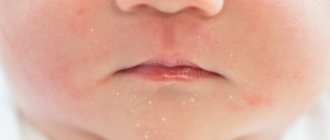Swelling of the nasal mucosa in a child is a characteristic symptom of a number of diseases. It represents a protective reaction to pathological changes in the body. Swelling occurs due to increased capillary permeability and accumulation of fluid in the tissues of the cavity. The lining of the respiratory tract in this case becomes a place for bacteria to accumulate. As a result, the child cannot breathe, his mood deteriorates, sleep and appetite disappear. In some cases, there is a threat of inflammation of the bronchi.
In the absence of sneezing and watery eyes, most parents do not attach importance to this problem. However, nasal congestion can occur without obvious signs of a runny nose. If the symptoms are ignored, it provokes a number of complications, including respiratory arrest. It is necessary to relieve swelling of the mucous membrane for basic safety reasons.
- Drops for vasoconstriction
Causes of the disease
There are several reasons for swelling of the nasal mucosa in a child.
Allergic reaction
Allergens may include:
- pet fur;
- mold and other microorganisms;
- pollen of grasses and plants;
- pile from carpets, rugs;
- medicines and food;
- dust and other household allergens.
Allergic swelling of the nose has distinctive signs. The moment the child comes into contact with the allergen, itching occurs, after which sneezing and watery eyes begin. The sense of smell is impaired, the voice changes.
Features of physiology
In newborn children, nasal swelling is a natural physiological process. The mucous membrane is not able to withstand the load, since in the womb of a woman the respiratory system does not work. The lack of formed regulatory processes leads to swelling of the nasal membrane. Over the next two years, the nasal passages widen and the problem disappears.
Polyps
Polyps are abnormal protrusions of tissue above the nasal mucosa. They are benign and do not cause pain when pressed. Outwardly they resemble a bunch of grapes. Doctors believe that the main reason for the formation of polyps is the anatomical imperfection of the structure of the body. The disease is characterized by nasal congestion and constant mucous discharge. The child experiences a decrease in sense of smell, disruption of diet, and deterioration in concentration. There is tinnitus and snoring. Lack of treatment leads to gradual closure of the nasopharynx.
Overgrowth of adenoids
Adenoids are tonsils in the nasopharynx, consisting of lymphoid tissue. During the inflammatory process, oxygen supply in them is disrupted. This provokes swelling of the sinuses, as well as signs of hypertrophy. Among the reasons for enlarged adenoids:
- low immunity,
- frequent colds,
- lack of useful microelements in the body.
Swelling of the nose is accompanied by a runny nose, a nasal voice and decreased hearing.
Mechanical injuries
The causes of nasal swelling in a child may include various injuries:
- closed,
- open,
- combined,
- with bone displacement
- without bone displacement.
Mechanical injuries often occur in children. These are evidenced by wounds and deformations of the nose. If breathing suddenly becomes difficult, and swelling is accompanied by pressure in the cavity, the fact of a foreign body entering the nose should be excluded. A small object can remain in the mucous membrane for several days. To rule out asphyxia, consult a surgeon. He will conduct a visual examination and refer you for x-rays.
Infectious process
Viruses are another cause of swelling. Almost all respiratory diseases begin with nasal congestion. This means that the infection has entered the body, but is in an inactive state. Its development is facilitated by factors that reduce immunity. The infectious process is accompanied by profuse lacrimation, as well as a complete cessation of breathing. Yellow mucus appears.
Types of fibroids
There are two types of tumors: soft and hard.
Soft fibromas in a child are characterized by very slow growth, rather flabby consistency, mobility and clear localization. Such growths occur mainly in the genital area and anus, sometimes forming multiple clusters. Solid neoplasms are smooth or slightly rough pink and flesh-colored nodules with dense contents. Such fibromas are located on a wide base and, as a rule, do not exceed 1 cm in size.
Symptoms and signs
Symptoms of sinus swelling in a child include:
- External increase in cavity tissue.
- Constant feeling of nasal congestion.
- Lack of normal breathing.
- Complaints of dizziness, pain in the temples.
- Increased body temperature.
With allergies, severe swelling of the nose is accompanied by sneezing. Redness is observed on the child's skin. Transparent mucus comes out of the nose.
The presence of infection provokes malaise, weakness and drowsiness. Babies experience lacrimation and snoring during sleep.
A bruise forms at the site of a mechanical injury. It is characterized by swelling and pain during palpation, and in some cases, internal hemorrhage. Lack of treatment increases the likelihood of complications such as loss of smell and purulent discharge.
Complications
Nasal polyps can cause complications both because of the chronic inflammation that accompanies them and because they interfere with nasal breathing and mucus drainage.
What complications can nasal polyps cause:
- Obstructive sleep apnea. This is a rather serious condition in which breathing is interrupted during sleep.
- Exacerbations of asthma. Chronic sinusitis can worsen asthma symptoms.
- Sinus infections (nasal and sinus infections). Polyps can make you more susceptible to infection and lead to chronic sinusitis.
Diagnosis of the disease
Diagnosis begins with a visit to the pediatrician. If the child does not feel improvement within a week, the doctor prescribes a consultation with an otolaryngologist. The initial examination involves:
- history taking and manual examination, during which the affected area of the nasal sinuses is established;
- analysis of urine and blood tests, which allows you to determine the severity of edematous changes;
- laboratory diagnostics, which involves the use of various cytological methods.
If necessary, the specialist will use the following research methods:
- Rhinoscopy.
A method of examining the cavity in which the doctor inserts closed mirrors into the nasal opening and then opens them inside. - Microrhinoscopy.
This method uses a self-supporting mirror, which allows the doctor to manipulate with both hands and take photographs of the nasal cavity. - Diaphanoscopy.
Transillumination of the paranasal sinuses with a beam of light to identify skin formations. - Fiberendoscopy.
Examination of the nasopharynx using an endoscope with a diameter of up to 3 mm. If an allergy is suspected, allergological and immunological studies are carried out.
Chalazion
Cones of this type are quite common. They develop from a sebaceous gland whose duct is blocked. This formation is also called a “grading lump” or “cold barley.” The continued production of sebaceous gland secretion leads to the accumulation of a viscous mass in the capsule, which stretches and thickens, taking the form of a dense lump. On palpation, the contents under the skin feel like a moving ball.
Cold barley develops at a slow pace, so it does not cause pain. Only a formed hard capsule can cause pain when squeezed. If a chalazion is not treated, it can develop into a cyst. As the lump develops, the risk of complications increases: inflammation, formation of a purulent fistula, granulation.
Treatment of nasal swelling in a child
The process of treating nasal swelling without a runny nose in a child requires an individual approach. An experienced doctor will be able to recognize the signs of the disease and prescribe the correct treatment regimen.
Drops for vasoconstriction
The latest generation of antihistamines are represented by nasal sprays and drops. Sialor Rhino copes well with nasal congestion in children of all ages. The function of the drug is to narrow the blood vessels in the nasal cavity.
Advantages of Sialor Rhino:
- fast and effective results,
- long duration of action (up to 12 hours),
- three dosage options,
- no cross-contamination (contamination of the product during production),
- convenient use.
The basis of the drug is oxymetazoline, a local-spectrum alpha-adrenergic stimulant. "Sialor Rhino" is administered intranasally. Within a few minutes, it reduces the level of swelling of the mucous membrane in the upper part of the respiratory tract. Thanks to the opening of the paranasal sinuses, the child feels noticeable relief of his condition.
Antiseptics and antibiotics
For respiratory diseases, nasal swelling is relieved with antiseptics. Such medications help reduce inflammation and restore healthy microflora. For convenience, we recommend choosing antiseptics in the form of drops.
The use of antibiotics occurs when the mucous membrane is swollen due to an infectious disease. They have a powerful effect on the child’s body, so treatment should be carried out exclusively under the supervision of a doctor. Additionally, you can use ointments based on eucalyptus, mint and pine needles.
Nasal rinsing
Nasal rinsing allows you to achieve the following results:
- removal of excess mucus,
- softening of the crust in the cavity,
- cleansing the mucous membrane,
- removal of dust and allergens,
- facilitating the breathing process,
- relieving inflammation.
The washing procedure is quick and uncomplicated. It is used not only for medicinal but also for hygienic purposes. Washing is carried out using saline solutions, sea water, and antiseptics. Duration of treatment is up to two weeks.
Physiotherapy
The following physiotherapeutic procedures help reduce swelling of the nasal mucosa in the absence of a runny nose in a child:
- Inhalations.
With warm inhalations, the baby inhales the sprayed medicine through the nose. At home, essential oils and herbal infusions are used. Steam penetrates into inflamed areas of tissue, eliminates pathogenic organisms and reduces the level of swelling. - Ultrasound therapy.
It is the effect of ultrasound on the nasal sinuses. Sessions last from 5 to 10 days. The procedure helps to dilate blood vessels, normalize blood flow and increase tissue regeneration. - Laser therapy.
An alternative treatment method in which the affected area is exposed to optical radiation. The duration of the course is from 5 to 12 days.
Surgical intervention
Surgical intervention is practiced in advanced cases - when drug treatment has failed. The operation is performed to remove the foreign body, eliminate growths and polyps, and remove inflamed adenoids. It is performed in a hospital under general or local anesthesia. The recovery period is from two to five days.
What to do?
When deciding on treatment for a cyst, an ENT specialist usually takes a wait-and-see approach. The fact is that the growth of education has been going on for decades. Therefore, as long as it is small and does not cause any discomfort, there is no need to touch it. In addition, although infrequently, a maxillary sinus cyst can empty on its own. There is no pain, and the contents of the “ball” flow out through the nose.
But if the pathology causes concern, then the only effective way to treat it is surgery. Many patients, fearing surgical intervention, try to get rid of the problem with the help of traditional medicine: they do rinses, instill herbal decoctions into the nose or lubricate the mucous membranes with them. There is no point in such procedures, since they only temporarily make breathing easier, but do not reduce the size of the formation.
Prevention
We recommend that you take timely measures to prevent your baby’s nasal congestion:
- monitor your child’s diet and sleep;
- take him out into the fresh air more often;
- avoid hypothermia;
- wean your child from bad habits (thumb sucking, nail biting, etc.);
- humidify the air in the apartment;
- do not use vasodilator drops;
- avoid mechanical injuries and damage;
- Avoid contact with external allergens.
Experts advise focusing efforts on improving the functions of the immune system. It is important to carry out timely prevention of respiratory diseases. Remember that following basic rules for caring for your baby’s health will help avoid swelling of his nasal cavity.
Risk factors
All conditions that cause chronic inflammation of the nasal passages or sinuses (infections, allergies) increase the risk of nasal polyps. The following conditions are most often associated with polyps:
- asthma;
- sensitivity to aspirin;
- allergic fungal sinusitis, allergy to fungal spores;
- cystic fibrosis (or cystic fibrosis);
- Churg-Strauss syndrome (a rare disease that causes inflammation of blood vessels);
- vitamin D deficiency;
- Some genetic variations related to the functioning of the immune system may increase the likelihood of developing nasal polyps.










